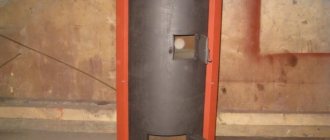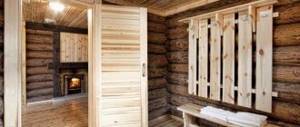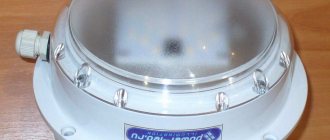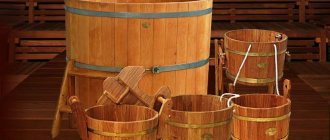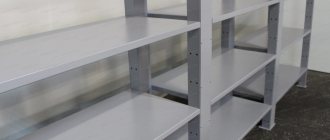Explaining to an experienced bathhouse attendant or an experienced steam lover why a stone mesh is needed on the pipe in the bathhouse is absolutely unnecessary. Anyone who has taken a steam bath at least once in their life knows how cruel and unforgiving a metal stove can be, especially a fire tube. This is a small section of metal chimney, only a meter long, connecting the flange of the furnace combustion chamber to the rest of the chimney duct.
A fire tube without a mesh with a stone heats the bathhouse too harshly
Why do you need a mesh for a pipe for stones?
If the dimensions of the steam room are large enough, for example, 3x4 m or more, then the mesh does not need to be installed on the pipe. If the room is heated according to all the rules, then the surface of the flame tube heats up to a crimson color. Tolerating the emanating heat is difficult, but possible for a while. The slightest attempt to steam or stand next to the heater and hot area for more than 5 minutes can result in burns to your arms, chest and back. Therefore, first of all, a mesh for the pipe is installed in the bathhouse in order to protect those who like to steam from powerful infrared radiation.
In addition, the use of a mesh grid helps improve the atmosphere in the bathhouse:
- The volume around the flame tube is filled with specially selected pebbles. Such a mesh heater on a pipe allows you to get a fairly large amount of steam without altering the stove;
- The mesh installed on the chimney, thanks to the protective layer of quartz stone, dries the air in the room less and at the same time protects the wooden finish of the walls and ceiling from overheating and even charring;
- It improves the dissipation of heat generated on the flame tube of the furnace, the infrared flow is less concentrated and better warms the air inside the bathhouse.
For your information! It is believed that the presence of a mesh with stone allows you to save the pipe material, which quickly corrodes when in contact with air and water poured onto the heater. Even stainless steel rots and burns, not to mention cheaper nickel-plated pipes.
There is an opinion that the flame pipe must be covered with thermal insulation or a ready-made sandwich version of the chimney must be used. On the one hand, this is true; a thermally insulated surface will reduce the infrared heat flow and make being near a metal stove more comfortable.
At the same time, there are two negative aspects of this decision. For example, most of the heat will evaporate through the chimney, and the stove and the heater itself will be of little use for the steam room. Secondly, the speed of combustion products in the chimney will increase sharply, the stove will be voracious, will require more firewood, and the actual heat transfer from it will not be increased. Therefore, a grid for stones on a sauna stove is not a whim, it is an extremely necessary element of the heater.
The classic version of the mesh for the heater in the bath
Criterias of choice
For the manufacture of such a device, a mesh made of stainless alloys is best suited. The use of raw metal materials is permitted. But you need to take into account that such nets are weakly resistant to moisture and temperature changes in the steam room. Over time, the decorative appearance of such devices will be spoiled by rust and oxidation.
Stones for lining the stove are selected according to the following criteria:
- Heat resistance - the structure of the stone must withstand high temperatures and sudden changes in heat and cold.
- Heat capacity is the ability to accumulate and retain heat from a stove for a long time.
- Stone fraction (size) – stones measuring 50x60 mm are suitable for small stoves. For larger structures, stones measuring 120x150 mm are suitable.
It is better to choose flat stones for laying in the net. This will allow the masonry to be compacted as much as possible and prevent water from entering the heated metal of the furnace.
The most affordable option is river or sea pebbles. When choosing this material, you must avoid stones with red veins. Such inclusions in the pebble structure indicate the presence of iron. The evaporation of iron oxides in the steam room does not improve the healing effect of the bath.
When choosing a design and material for making a mesh, you should proceed from factors such as:
- Volume and weight of stones. The structure must support the weight with reserve. If you choose an aesthetic material with an elegant pattern and do not calculate the weight, the structure will deform and become ugly.
- Installation location: on the chimney or around the stove body.
- Material for production. Heat-resistant stainless steel is expensive, but does not deform or lose its appearance when heated repeatedly. A product made of ferrous metal (ordinary structural steel) will have to be made thicker and more massive, and to protect it from corrosion, it will have to be periodically tinted with heat-resistant enamel.
- Manufacturer's reputation and cost. In stores in Moscow and other cities, nets from 800 rubles from unknown manufacturers are presented. Obviously, such a product of garage tycoons will not last even a season. A reasonable price for ferrous metal mesh starts at 2000 rubles.
- If the products presented in stores do not suit the buyer in terms of price, shape, finish or other parameters, a simple mesh can be made with your own hands. It is suitable for both a Russian bath and a sauna.
We invite you to familiarize yourself with the Slope for draining water in a bathhouse
Mesh for stones - options
There are quite a lot of different options and schemes for making a mesh shell under a stone. Each of them is interesting in its own way, but if you do not engage in professional production of grids for stones for the stove, then it is best to use long-tested projects that are easy to make with your own hands.
The list of the most popular models includes:
- Structures in the form of a shell made of mesh with cell sizes of 20x20 mm and 40x40 mm. The height of the mesh on the chimney is equal to twice the diameter;
- Rod or reinforcement grids for stones on a pipe. The dimensions of the structure can be very different, from one and a half meter shells to small rectangular and square baskets; the design most often copies the device of a standard heater - a grate for stones on a stove in a bathhouse;
- Ring attachments made of perforated sheet metal. The most attractive and durable of all mesh options for bath pipes.
In addition, there are non-standard schemes and designs for stone. The fact is that the chimney pipe from the stove is not always directed vertically to the ceiling. If the chimney is located outside the steam room, then you have to make a swivel elbow. In this case, the mesh for stones on the chimney must be assembled from several sections. The result is a mesh rotating elbow, approximately the same as in the photo.
An unusual version of the mesh with stone, the chimney is built outside the bathhouse
Despite the unusual appearance, this design works extremely efficiently, primarily due to the fact that water, splashing onto the rocky backfill, does not flow down onto the furnace body, but remains on the surface of the flame tube and evaporates almost completely.
Assembling a wooden floor grating
We will prepare wooden blanks and their subsequent assembly based on the sketch shown below in the text.
Due to the simplicity of the design, it makes no sense to describe in detail the order of assembling the grille. It is worth noting only the following points:
- For the flooring, black alder boards will be used, from which the shelves for the steam room . The advantage of such boards is that they are already completely processed.
- The gap between the boards should be within 20 - 25 mm.
- The boards (flooring) will be fastened with self-tapping screws from the outside of the crossbars.
- The working surfaces of all wooden elements must be thoroughly cleaned with fine abrasive sandpaper, and the sharp edges must be chamfered.
- At the fastening points in all crossbars, it is necessary to drill holes for self-tapping screws 0.5 mm larger than their diameters. To do this, you should first make a test assembly of the grille and then mark the center for the holes.
- If difficulty arises when inserting self-tapping screws into the flooring boards, then you will need to drill blind holes in them with a diameter of 0.5 - 1.0 mm less than the diameter of the self-tapping screw.
- Assembly should begin with the outer crossbars and after that the remaining elements should be secured. The screw caps should be recessed into the body of the crossbars to a depth of 1 mm.
- To prevent the grate from sliding on the floor, you can attach rubber pads or special feet to the support crossbars.
It would be good to coat the manufactured wooden grating with Paraffin Oil, which was used when updating the lining . This will preserve its appearance and increase its service life by protecting it from rotting.
Homemade sauna accessories are of undoubted value. In addition to material gain, a person also experiences a feeling of moral satisfaction. And a wooden grate is another useful craft in the range of bath accessories.
Dear friends! If it’s not difficult, share it on these social networks with your friends. Thank you!
How to choose a grid for stones on the stove
The choice of a specific mesh model for stones in a bathhouse depends on the size of the pipe and steam room. For a small bathhouse with a stove power of 5-7 kW, you can use the lightest homemade nets. If a full-fledged metal stove of 12-15 kW was purchased for a bathhouse, then perhaps it would be more rational to use a lattice structure rather than a mesh one.
Efficiency of mesh shells
The undoubted advantage of the mesh is its low weight and versatility of fastening. Most models of mesh for stones on the chimney have a clamp fastening, which allows you to install the nozzle on a pipe with a diameter of 100 to 150 mm.
Important! The mesh shell is quite soft and does not create additional bending stresses that can bend the chimney pipe.
Such structures have the lowest shielding coefficient of the rocky backfill, that is, all the heat emitted by the stones is easily transferred into the air of the bathhouse. The poured boiling water completely turns into steam and goes into the air without encountering resistance from the metal wire. A serious drawback is that the production uses wire or ready-made mesh made of stainless heat-resistant steel AISI430. Due to the high content of chromium and silicon, such metal is difficult to bend, weld, or cut with a hacksaw.
The mesh can be up to a meter high
One of the most popular models of mesh for a sauna stove is made of thin millimeter wire; as a result, the shell itself is soft and elastic, so the body has to be reinforced with additional rings. A metal cone is installed at the bottom. This allows you to make the mesh more rigid, preventing stones from pushing out the walls, and at the same time protects the stove flange from leakage of boiling water that has not evaporated.
Lattice structures
A grate for stones on a pipe has much greater strength, so the height of the structure can reach a meter or more. Such a basket is made in the form of vertical reinforcing bars, not necessarily even from alloy or heat-resistant metal, tied at the bottom and top of the grid with steel rings.
Such a grill will require strengthening the chimney of the bathhouse
Used on the most powerful stoves for large bathhouses. In terms of heat transfer efficiency, they are practically not inferior to a mesh scheme, but at the same time they require special attention when installed on a pipe. Since significant thermal deformations occur during heating, as a result, the chimney pipe can be pressed through the rocky backfill.
Baskets for pipes made of sheet material
The most attractive and easy-to-manufacture option for a pipe grate. The result is a fairly strong and reliable grille. Positive qualities include the elegant decorative appearance of chromed metal.
The disadvantages usually include a high surface shielding coefficient
This means that a ladle of boiling water poured on top of the stones can lead to the appearance of a very powerful jet of steam in the most unexpected place. Hot steam escaping from the vent in an unpredictable direction can cause burns.
Varieties
Each mesh is selected individually, taking into account consumer preferences, as well as the shape and size range of the stove itself.
The shape of the mesh can be round, square, cone-shaped, diamond-shaped or oval. The mesh can be made in the form of a lattice or basket.
The length of the mesh is also calculated based on the dimensions of the chimney. The economizer can be the length of the entire chimney pipe, or maybe half or even a quarter.
The grid can have a specific design or can be made in a minimalist style. Manufacturers often make mesh from thick or thin rods, which are arranged in a diamond or square shape.
Do-it-yourself pipe mesh for stones
It is not difficult to make a grate or mesh shell for the rock backfill around the stove chimney, the main problem that you may have to face is the lack of suitable material. It is difficult to find mesh grids with the required mesh size on the open market, so you have to be content with parts borrowed from other devices and devices.
Materials and tools
First of all, you need to decide on the material of the mesh for the stones in the bathhouse. Three types of mesh are definitely not suitable for making shells:
- Welded fabric made of 2-3 mm wire, used for the manufacture of fences;
- Popular and cheap chain-link, regardless of size;
- Household mesh used in kitchen and home appliances.
In all cases, the mesh is made of a soft, ductile metal, most often low-carbon steel. To prevent corrosion, the surface of the wire is covered with a layer of zinc, paint or polymer; you can find an aluminum or nickel-plated coating.
Important! All versions of household nets, when installed on the fire pipe of a bathhouse chimney, burn, releasing a large amount of toxic substances. Even including zinc and aluminum.
Galvanized mesh cannot be used
It is necessary to select a metal mesh with a cell size of 0.5-20 mm, always made of alloy or stainless steel. Such materials are used as filters - spark arresters in the chimney of a bathhouse, and in industrial ventilation systems.
In addition, you will need a small amount of:
- Thin sheet stainless steel, it is usually used for protective screens inside the bathhouse;
- Brass or steel rivets;
- Round blank for bending workpieces;
- Cutting and welding tools – grinder, metal scissors, inverter.
In addition, you will need to stock up on a set of drills sharpened for drilling stainless steel, and a drill with a function for adjusting the rotation speed of the chuck.
Design and drawing
If you managed to get a full-fledged mesh made of real stainless steel, then the project below will be the most convenient option for manufacturing.
Convenient option for a small bath
This is the most preferable option; its production will take no more than 3 hours of work, and in addition, such a structure can be made quite high, up to a meter or more.
If you only managed to get a fine mesh mesh, then it would be better to make a nozzle for a pipe for a stove in a bathhouse according to the diagram given below.
A little more difficult to manufacture, but it has a lot of additional advantages. An additional cone in the lower part of the body protects the stove from streams of hot water, which means that anyone who sprays the heater with boiling water is guaranteed not to receive a thermal burn from hot steam.
Manufacturing stages
If you choose a fine-mesh material for manufacturing, then first of all it is necessary to form the outer walls of the nozzle. The mesh is wrapped around a blank with a diameter of 30 cm and fixed with two wire clamps. The edges, everything that extends beyond 50 cm on the sides, is trimmed with a grinder.
Spark arrestor filter element, perfect for stone on a sauna chimney
It is necessary to cut three strips of 40 mm wide and 90-100 cm long from stainless steel sheets. From the blanks, choose one that is the most even. Using metal scissors, cuts of 5-10 mm are made along the strip, in increments of 15-20 mm. The smoothest ones will be used to make the upper and lower rings. From the prepared workpiece it will be possible to bend a ring for the upper part of the shell. To do this, the strip is placed on the end of the bending blank and carefully bent, tapping the metal with a hammer.
From the remaining two strips, two middle rings are bent, one internal, one external. The diameter is selected according to the size of the blank.
All that remains is to make the lower cone of the shell. To do this, mark a circle blank with a diameter of 40 cm on a sheet of metal, inside which there will be a hole with a diameter of 100 mm. The circle is cut out with metal scissors and an incision is made from the edge to the center. At least two dozen holes must be drilled into the metal surface, arranged in a chaotic manner. The cone is bent by hand and adjusted in diameter to the size of the bending blank.
Mesh installation
A homemade stone mesh is assembled directly on the stove pipe. First of all, a cone is installed on the chimney, lowered to the body, aligned along the axis and welded to the top plate of the bathhouse stove. Next, you need to put on a wire-knitted mesh. To prevent the web from unfolding, two mounting rings are installed inside the shell and simultaneously outside, they are secured with rivets or welding points directly to the metal of the mesh sheet.
The top ring is put on last. It is put on top of the mesh and secured either with wire or with a welding inverter. To prevent the mesh for stones in the bathhouse from deflecting under load, the upper ring can be secured to the chimney pipe of the bathhouse with an additional transverse strip of metal.
Advice! If the structure is supposed to be periodically removed and removed from the room in the bathhouse, then it is best to use the clamp fastening shown in the first mesh design.
The only difference is that you will need to make at least two clamps and weld them to the cone and to the top ring.
Laying stones
The given version of the mesh shell involves the use of stones of three sizes. It is planned to place small quartz chips and pebbles up to 25-30 mm in size into the cone located in the lower part of the structure. The middle part can be filled with larger stones, up to 50 mm. The remainder from the middle and above is filled with large stones.
Quartzite and chalcopyrite
When selecting backfill material, you should try not to use stones with sharp edges. After two to three months of use in the bathhouse, the sharp edges crumble and crumble inside the structure. This must be taken into account if you are making a mesh for a stone cloth with a large cell size.
